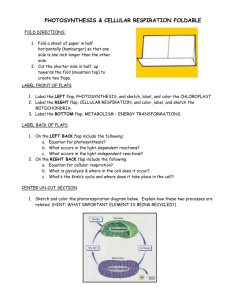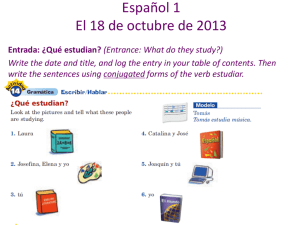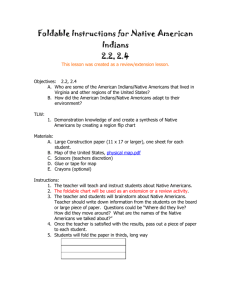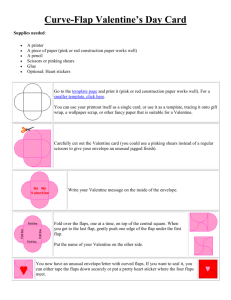Problem: Improving the vocabulary and reading ability of my deaf
advertisement
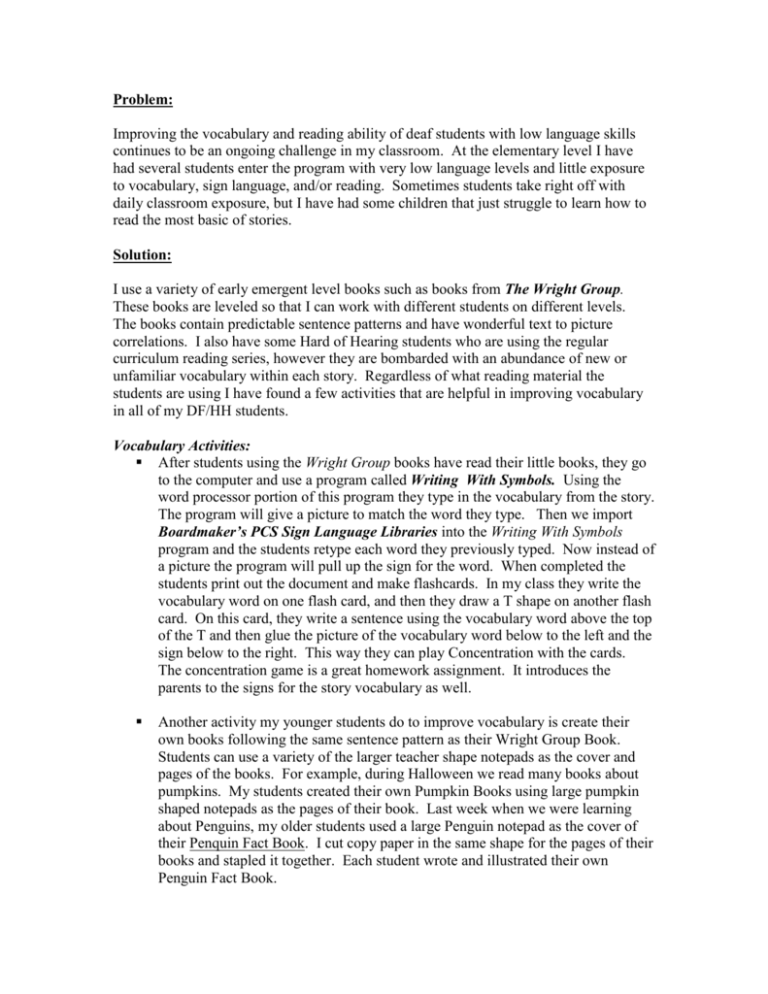
Problem: Improving the vocabulary and reading ability of deaf students with low language skills continues to be an ongoing challenge in my classroom. At the elementary level I have had several students enter the program with very low language levels and little exposure to vocabulary, sign language, and/or reading. Sometimes students take right off with daily classroom exposure, but I have had some children that just struggle to learn how to read the most basic of stories. Solution: I use a variety of early emergent level books such as books from The Wright Group. These books are leveled so that I can work with different students on different levels. The books contain predictable sentence patterns and have wonderful text to picture correlations. I also have some Hard of Hearing students who are using the regular curriculum reading series, however they are bombarded with an abundance of new or unfamiliar vocabulary within each story. Regardless of what reading material the students are using I have found a few activities that are helpful in improving vocabulary in all of my DF/HH students. Vocabulary Activities: After students using the Wright Group books have read their little books, they go to the computer and use a program called Writing With Symbols. Using the word processor portion of this program they type in the vocabulary from the story. The program will give a picture to match the word they type. Then we import Boardmaker’s PCS Sign Language Libraries into the Writing With Symbols program and the students retype each word they previously typed. Now instead of a picture the program will pull up the sign for the word. When completed the students print out the document and make flashcards. In my class they write the vocabulary word on one flash card, and then they draw a T shape on another flash card. On this card, they write a sentence using the vocabulary word above the top of the T and then glue the picture of the vocabulary word below to the left and the sign below to the right. This way they can play Concentration with the cards. The concentration game is a great homework assignment. It introduces the parents to the signs for the story vocabulary as well. Another activity my younger students do to improve vocabulary is create their own books following the same sentence pattern as their Wright Group Book. Students can use a variety of the larger teacher shape notepads as the cover and pages of the books. For example, during Halloween we read many books about pumpkins. My students created their own Pumpkin Books using large pumpkin shaped notepads as the pages of their book. Last week when we were learning about Penguins, my older students used a large Penguin notepad as the cover of their Penquin Fact Book. I cut copy paper in the same shape for the pages of their books and stapled it together. Each student wrote and illustrated their own Penguin Fact Book. Another activity we frequently do is Vocabulary PowerPoint. By using the templates that allow you to insert clip art you can have the students type their vocabulary words or spelling words in the top box of the template, write a definition and a sentence using the word in the lower text box, and then click on the Clip Art symbol to insert a picture of the vocabulary word. When the students click on the Clip Art icon and type in the vocabulary word and it will pull up all pictures related to the word entered. This is helpful in that the children do not have to spend an abundant amount of time searching for a picture to match the vocabulary word. (It can also serve as a red flag to the teacher if the student consistently chooses pictures that are not appropriate.) Microsoft Word Art can be used in a similar way. We recently did a unit on adjectives. Students used Word Art to illustrate their assigned adjective. For example: We make Vocabulary Flip Books frequently to practice story vocabulary. Fold a sheet of paper in half long ways, then fold it back the other way (so that your paper resembles an M or zig zag). Next, hold the middle of the M together and staple the paper together at the top underneath the flaps. Then cut the two flaps on either side up to the fold line so that we have a front and a back both with four or five flaps (see below). I have my students with low language abilities write the vocabulary word on the outside of the flap, illustrate the word on the inside of the flap at the top, and write a sentence on the lower half. (See example below – This student glued on a picture of the word and the sign of the word, then wrote a sentence below.) Students with more advanced language skills are asked to write the definition on the outside of the flap and put the vocabulary word and illustration under the flap. This has been an extremely helpful activity to use with Science Vocabulary in 4th and 5th grades. (side view) (front view of front only) Impact: The impact of these activities has been that my students’ abilities to remember and recall story vocabulary have improved noticeably. Students are able to use the Flip Books they have made as a tool to review and practice their story vocabulary. I have noticed that my students are beginning to enjoy literacy activities more. They are beginning to ask for signs of words they do not know. Another improvement I have noticed is that my students will use the clip art portion of the Microsoft Word or Microsoft Power Point program as a sort of “reverse dictionary”. When they come across a word in their independent silent reading time and I am working with another student, they have always been encouraged to use the ASL Sign Language Dictionary on CD ROM. Now they have begun to go to the computer and pull up Clip Art. Then, they type the word into the search line in hopes of bringing up a picture of the unfamiliar word. Often times they recognize the picture and know a sign for it. My students enjoy printing out their reading stories in sign language to take home and share with parents, siblings, and friends. Contact Information: Jennifer Maxwell jmaxwell@ccboe.net Columbia County Blue Ridge Elementary School 550 Blue Ridge Drive Evans Georgia, 30809

